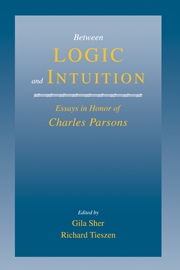Book contents
- Frontmatter
- Contents
- Preface
- I LOGIC
- Paradox Revisited I: Truth
- Paradox Revisited II: Sets – A Case of All or None?
- Truthlike and Truthful Operators
- ‘Everything’
- On Second-Order Logic and Natural Language
- The Logical Roots of Indeterminacy
- The Logic of Full Belief
- II INTUITION
- III NUMBERS, SETS AND CLASSES
- Name Index
Truthlike and Truthful Operators
Published online by Cambridge University Press: 02 December 2009
- Frontmatter
- Contents
- Preface
- I LOGIC
- Paradox Revisited I: Truth
- Paradox Revisited II: Sets – A Case of All or None?
- Truthlike and Truthful Operators
- ‘Everything’
- On Second-Order Logic and Natural Language
- The Logical Roots of Indeterminacy
- The Logic of Full Belief
- II INTUITION
- III NUMBERS, SETS AND CLASSES
- Name Index
Summary
Introduction
There is a time-honored tradition, let's call it the implicational tradition, according to which truth and implication systematically mesh with each other. In outline, the idea is simple; in detail, adherence to the tradition can get snagged. There are, of course, the well-known challenges posed by the truth paradoxes. The responses to those challenges have been either to restrict the kinds of structures on which truth and implication interact or to modify the notion of truth, or implication, or various combinations. Central to all these deliberations has been the Tarski Equivalence Condition. In what follows, I call any sentential operator “T” (one that maps statements to statements) truthful if and only if it satisfies the Tarski Equivalence Condition: for all A, “T(A)” is equivalent to “A”. Once I describe some conditions that link truth with implication, it becomes evident that there is a natural class of operators (I call them truthlike operators) that satisfies those conditions, and that although the class contains operators that satisfy the Tarskian condition, it also contains a good deal more. Those operators that are truthlike but not truthful are called definitely truthlike.
The truthlike operators as a whole have some interesting features. They behave extremely well with respect to the logical operators, and no two of them are comparable (in a sense to be explained) to each other. In particular, none of them is comparable to any Tarskian operator.
- Type
- Chapter
- Information
- Between Logic and IntuitionEssays in Honor of Charles Parsons, pp. 27 - 53Publisher: Cambridge University PressPrint publication year: 2000



